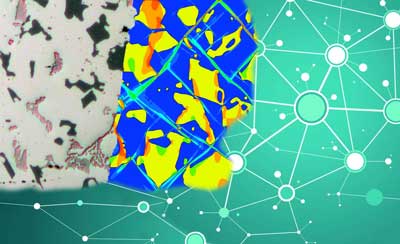| Dec 04, 2018 |
Materials data space for additive manufacturing: Creating digital twins of materials
|
|
(Nanowerk News) To ensure the digital networking of production systems and the optimization of material-specific requirements, we need to measure, analyze and replicate the changes in material properties in a process in which digital twins of materials are created. The materials data space developed by Fraunhofer researchers has laid the groundwork for this process.
|
|
When a finished part rolls off the production line, this is one of the first questions always asked: "Does this component have the properties I want?" Often, even the tiniest of variations in the production environment are enough to alter a part’s material properties – and throw its functionality into question.
|
|
Manufacturers avoid this by meticulously inspecting samples throughout the production process. Breaking down the samples into their composite parts and measuring them separately is an extremely time-consuming process.
|
|
"The outcome of the sample testing process branches out into an array of different subsets, each with their own specific measurement results," explains Dr. Christoph Schweizer, Head of the Assessment of Materials, Lifetime Concepts business unit at the Fraunhofer Institute for Mechanics of Materials IWM in Freiburg. "While experts may be able to keep an overview of the complex interrelationships in their heads, until now there has been no way to take the diversity of resulting data and portray it in a coherent digital format."
|
A digital twin for each material
|
|
Now, for the first time, researchers at the Fraunhofer IWM have developed a proof of concept demonstrating that it is possible to digitally represent many such material processing cycles with a materials data space for test specimens produced using additive manufacturing.
|
|
"The data space concept allows us to integrate any type of material information into a digital network – a really valuable tool, especially in the context of Industrie 4.0," says Schweizer. "We want to use the materials data space to automatically generate a digital twin of each material that will mirror the current state of the physical object under examination."
|
 |
| Data spaces can be used to integrate all types of materials information into digital networks - a valuable tool for production in the context of Industrie 4.0. (Image: Fraunhofer IWM)
|
|
The advantage of the materials data space is that it provides an overview of all relevant parameters at a glance, whereas formerly data on different material parameters was scattered among numerous data repositories in many different formats. But the real promise lies further ahead.
|
|
"In the years to come, the materials data space has the potential to become the production command center. Whenever component quality isn’t up to the expected standard, you can compare it with information on previous components stored in the materials data space to determine whether the present component can in fact be used or whether it must be rejected," says Schweizer.
|
|
In the future, these results could be automatically integrated into industrial decision-making processes: whenever component quality dips below the required standard, production automatically comes to a halt.
|
An ontology-based materials framework
|
|
Creating the data space –and managing the diversity of materials data – calls for a corresponding information model.
|
|
"In this case, the model reflects the natural material world, in which material states and properties are assigned to defined categories," explains Dr. Adham Hashibon, researcher in manufacturing processes at the Fraunhofer IWM.
|
|
Researchers draw on an ontology-based framework of fixed logic and hierarchy. The best way of thinking about it is in terms of a social network, like Facebook. Each person on Facebook is a node in the network. And in turn, these nodes have their own associations, for instance, taste in music.
|
|
"What we do is to create semantic relationships between the individual material objects and their associated processing steps," says Hashibon.
|
|
Then there are also interrelationships among these communities. What would be a friendship on Facebook is represented in the materials data space by details on the chronological sequence of production or work steps, for instance "leaving the additive manufacturing process" or "this laser is part of the 3D printing process".
|
|
The new demonstrator for additively manufactured metal components (mentioned earlier) has the capacity to generate samples, characterize the materials they contain, conduct subsequent data analysis and determine material properties.
|
|
Thanks to the logic underpinning the model, users can make extremely complex queries of the data space that simply wouldn’t be possible with the same degree of flexibility in the case of a conventional database.
|
|
Through its pioneering work on digitalized data spaces, the Fraunhofer IWM is making a significant contribution to European initiatives on materials modeling as part of the European Materials Modelling Council, as well as to the Digitalization Strategy of the German state of Baden-Württemberg.
|
|
In the medium term, the researchers intend to convert all data administration functions used by the Fraunhofer IWM to the data space model. They are currently looking for collaboration partners and pilot users for this and other applications, who will then share the chance to shape innovative new materials developments.
|

